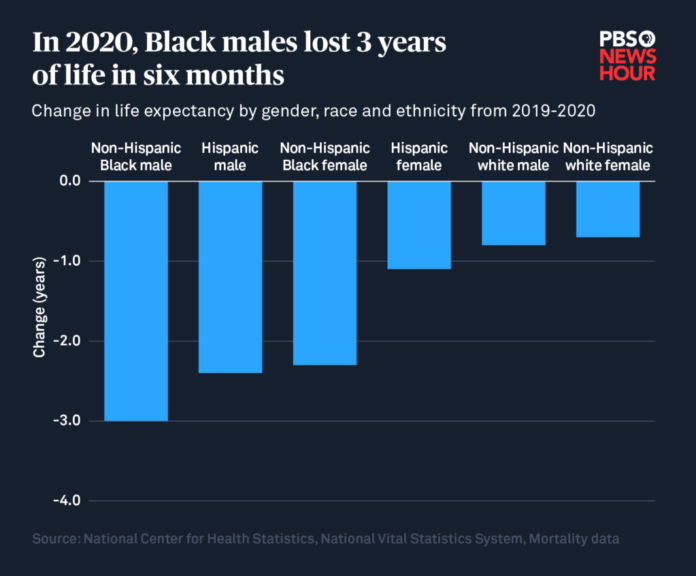
By Stacy M. Brown
NNPA Newswire Senior National Correspondent
@StacyBrownMedia
A new report from the National Center for Health Statistics shows the life expectancy for Americans decreased between 2019 and 2020.
For Hispanics and African Americans, research is particularly grim.
Between 2019 and 2020, life expectancy decreased by 3 years for the Hispanic population, 2.9 years for African Americans, and 1.2 years for white Americans.
In 2020, the Hispanic population had a life expectancy advantage of 1.2 years over the non-Hispanic white population, declining from an advantage of 3 years in 2019.
The Hispanic advantage relative to the non-Hispanic Black population decreased from 7.1 to 7.0 years between 2019 and 2020, researchers found.
The non-Hispanic white life expectancy advantage relative to the non-Hispanic black population increased from 4.1 to 5.8 years between 2019 and 2020.
Life expectancy for the African American population has consistently been lower than that of the white population, but the gap had been narrowing during the past three decades, from 7.1 years in 1993 to 4.1 years in 2019.
The last time the gap in life expectancy between the white and Black populations was this large was in 1999. Conversely, the gap between the Hispanic and non-Hispanic white populations decreased by 60% between 2019 (3.0) and 2020 (1.2).
Among the six Hispanic origin – race and sex groups, the decrease in life expectancy between 2019 and 2020 was greatest for Hispanic males, whose life expectancy declined by 3.7 years (79.0 to 75.3), followed by non-Hispanic Black males with a decline of 3.3 years (71.3 to 68.0), non-Hispanic Black females with a decline of 2.4 years (78.1 to 75.7), Hispanic females with a decline of 2.0 years (84.4 to 82.4), non-Hispanic white males with a decline of 1.3 years (76.3 to 75.0), and non-Hispanic white females with a decline of 1.1 years (81.3 to 80.2).
“Increases or decreases in life expectancy represent the sum of positive and negative contributions of cause specific death rates. Declines in cause specific mortality contribute to increases in life expectancy while increases in cause-specific mortality contribute to decreases in life expectancy,” researchers wrote.
If the negative contributions (i.e., increases in cause-specific death rates) are greater than the positive contributions (i.e., decreases in cause-specific deaths rates) then the result is a decline in life expectancy, the researchers added.
If negative and positive contributions offset each other, then the result would be no change in life expectancy, they continued.
The decline of 1.5 years in life expectancy between 2019 and 2020 was primarily due to increases in mortality due to COVID-19 (73.8% of the negative contribution), unintentional injuries (11.2%), homicide (3.1%), diabetes (2.5%), and Chronic liver disease and cirrhosis (2.3%).
The decline in life expectancy would have been even greater were it not for the offsetting effects of decreases in mortality due to cancer (45.2%), Chronic lower respiratory diseases (CLRD) (20.8%), heart disease (5.0%), suicide (4.6%), and certain conditions originating in the perinatal period (4.0%), the report noted.
For the male population, the 1.8-year decline in life expectancy was mostly due to increases in mortality due to COVID-19 (68.7%), unintentional injuries (14.0%), homicide (4.4%), diabetes (2.4%), and Chronic liver disease and cirrhosis (2.3%).
The report further outlined that the decline in life expectancy was offset by decreases in mortality due to cancer (51.7%), CLRD (17.5%), Influenza and pneumonia (5.3%), Alzheimer disease (4.7%), and suicide (4.6%).
For females, the decline in life expectancy of 1.2 years was primarily due to increases in mortality due to COVID-19 (79.8%), unintentional injuries (6.8%), diabetes (2.7%), Chronic liver disease and cirrhosis (2.3%), and homicide (1.0%).
These effects were offset by decreases in mortality due to cancer (34.7%), CLRD (21.2%), heart disease (16.3%), suicide (4.1%), and stroke (3.7%), the researchers found.
The Hispanic population experienced the largest decline in life expectancy between 2019 and 2020 (3.0 years).
This decrease was primarily due to increases in mortality due to COVID-19 (90.0%), unintentional injuries (4.2%), diabetes (1.8%), homicide (1.0%), and Chronic liver disease and cirrhosis (0.9%) (Figure 6).
The decline in life expectancy would have been greater were it not for the offsetting effects of decreases in mortality due to cancer (38.2%), heart disease (14.1%), stroke (9.7%), CLRD (9.1%), and Alzheimer’s disease (8.4%).
The second greatest decline in life expectancy was experienced by the non-Hispanic Black population (2.9 years).
The decline was due primarily to increases in mortality due to COVID-19 (59.3%), unintentional injuries (11.9%), homicide (7.7%), heart disease (5.9%), and diabetes (3.6%).
The decrease in life expectancy was offset by decreases in mortality due to cancer (68.0%); Certain conditions originating in the perinatal period (11.3%); Congenital malformations, deformations and chromosomal abnormalities (4.4%); Aortic aneurysm and dissection (2.5%); and Pneumonitis due to solids and liquids (2.2%).
“The study reveals hidden, heartbreaking pandemic,” Centers for Disease Control and Prevention Director Dr. Rochelle Walensky tweeted. “The Americas had more children experiencing death of caregivers due to COVID-19 than all other regions combined, and account for an estimated 53 percent of the 1.5 million global caregiver losses among children.”

